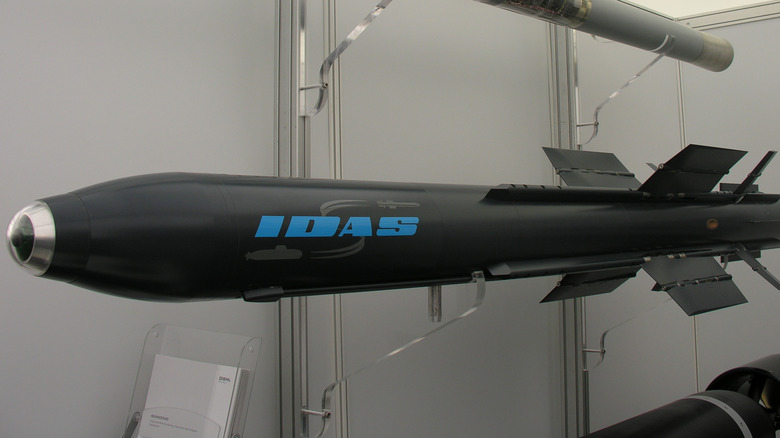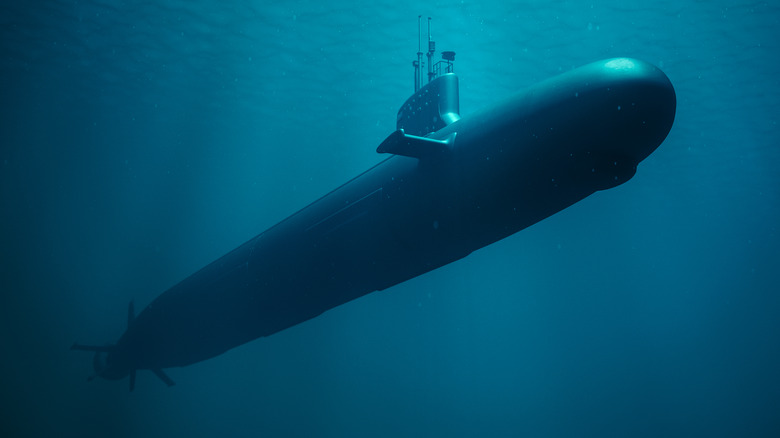Yes, Submarines Can Shoot Down Planes: Here's How Their Anti-Aircraft Missiles Work
In warfare, the threat from the air is so great that measures are taken to counter it from the land and sea as well as the sky. Anti-aircraft weapons have taken a wide range of forms, from the gun batteries and strategically placed barrage balloons of World War II to today's advanced air-to-air missiles that have the versatility of a surface-to-air missile, carried by such formidable fighters as the Eurofighter Typhoon and F-16 Fighting Falcon. Naval ships, too, are armed with the means to destroy aerial threats — not just surface ships, but also submarines.
While Germany's Interactive Defense and Attack System for Submarines — IDAS to its friends – hasn't yet seen active combat use, the system being developed by Diehl Defense and Thyssenkrupp Marine Systems represents an incredible addition to a submarine's arsenal. Ejected on the submarine commander's order, it will use advanced imaging infrared detectors to maneuver in the direction of its flying target while still submerged. Then it will breach the surface, accelerate, and – controlled by an operator in the sub — strike its airborne foe.
The innovation of the IDAS
The concept behind IDAS is to provide high firepower against anti-submarine-warfare helicopters in particular, without the need to compromise either the safety of the sub or the ability to maintain control over the projectile. After all, a potential danger of a submarine with anti-aircraft weapons is that those weapons' use could reveal the vessel's position to the aircraft. How to combat a helicopter designed to hunt you, then? Here's the key to the IDAS system, says Thyssenkrupp: "For the engagement it is not necessary that the submarine risks further detection by showing mast mounted optical or [electronic support measure] sensors or even by surfacing."
Unlike other weapons systems, the IDAS missile is launched beneath the waterline, letting the submarine continue to deploy its defense against airborne dangers: remaining deep in the water, out of detection range. A fiber-optic connection via a trailing cable ensures that operators have direct control and can see the missile's progress on the way to its target. Perhaps it would have been less complex to develop a version that can only be fired when the sub has surfaced, but as is already clear, a submarine firing at an aircraft from above the waterline is typically in a very unfavorable position.
The history of submarines' weapons against aircraft
You'd probably expect aircraft and submarines not to have much direct combat experience with one another. After all, a sub's main strategy is to conceal itself beneath the waves. However, historically submarines haven't spent as much time beneath the waves, or been as stealthy and difficult to target, as you might think. World War I submarines participated in significant battles, but as Norman Polmar put it in the U.S. Naval Institute's Naval History Magazine, "Beginning in World War I, British and U.S. airplanes and blimps attacked German U-boats operating on the surface, where submarines normally sailed — at least until the advent of nuclear propulsion in the 1950s."
The submarines, in return, frequently wielded anti-aircraft guns. Of course, these tended to be focused more on defense than attack, but this isn't to say that they weren't potent. In fact, experimental efforts have yielded some considerable weapons for submarines to bring to bear against aircraft, including a solution much akin to the portable rocket-propelled grenades that have been wielded against tanks. In the case of submarines, these were man-portable surface-to-air missiles, and one prominent example was the U.K-developed Blowpipe (pictured above being fired), introduced as a potential solution in 1975.
In short, submarines have long held the capacity to shoot down aircraft, but developing the capacity to do so practically, without risking significant danger in the process, has been a different matter entirely. The German-developed IDAS system represents a significant step forward.
More benefits of the IDAS missile system
On reaching the open air, the infrared detecting capabilities of the IDAS missile let it home in on the target. This helps the submarine that fired maintain a great degree of stealth, because it's hard to detect where the attack came from. It's a sophisticated concept, and one you might expect to require a significant overhaul of existing systems for submarines to adopt. A masterstroke of the design, however, is that it has been developed to minimize compatibility issues. For instance, the tube system used to administer the missiles is the same size as that of a more conventional torpedo already in use. Says Thyssenkrupp: "This allows an easy integration for new submarine building projects as well as for refit solutions of existing submarines."
The concept is similar in theory to drone warfare, in that the human operator retains control and can direct the payload carefully to a target while watching its progress. At the same time, they have the benefit of operational distance, keeping personnel safer.
As potent as it's designed to be against aerial targets, though, the missile is also designed to be able to combat other threats, including those on land. The project began with the goal of a range of more than nine miles, and though its true battlefield capacities haven't been demonstrated yet, it's clear that this is one of the most versatile weapons a submarine has ever been equipped with.
It's unclear what the future holds for IDAS
In spite of its great potential and the ease with which it may be able to be implemented in existing systems, a lot surrounding the IDAS weapon system remains theoretical. The system has been in development for over a decade, and has engaged only in test firings and experimental efforts to date.
In May of 2015, Thyssenkrupp engaged in tests to see how the missile would behave when released in specific situations. In 2016, its underwater-firing capacities were tested by Norway's HNoMS Uredd, the first Norewegian naval vessel to do so. Three years later, a Request for Proposal came from the German procurement agency BAAINBw, meaning the time had come to begin finalizing IDAS' capabilities and ultimately making it a reality for German HDW Class 212A submarines. And in January 2025, the missile was reported to be on course to arrive between 2030 and 2040.
This is quite a departure from the initial hope that it would be completed by 2014, but the submarine crews who work in vessels outfitted with it should ultimately be much safer from their greatest predators with the completed version installed. Submarines have had a huge impact on the evolution of naval warfare, and this new system could represent the next significant step in that evolution. Perhaps the U.S. Navy's substantial submarine fleet might wield it in the future.




